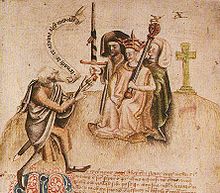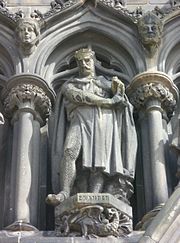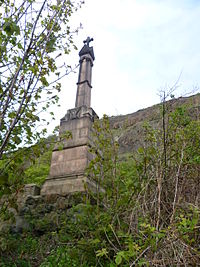- Alexander III of Scotland
-
Alexander III Coronation of King Alexander on Moot Hill, Scone. He is being greeted by the ollamh rígh, the royal poet, who is addressing him with the proclamation "Benach De Re Albanne" (= Beannachd Dé Rígh Alban, "God Bless the King of Scotland"); the poet goes on to recite Alexander's genealogy. By Alexander's side is Maol Choluim II, Earl of Fife holding the sword. King of Scots Reign 6 July 1249 – 19 March 1286 Coronation 13 July 1249, Scone Predecessor Alexander II Successor Margaret (disputed) Spouse Margaret of England
Yolande de DreuxIssue Margaret, Queen of Norway
Alexander, Prince of ScotlandHouse House of Dunkeld Father Alexander II Mother Marie de Coucy Born 4 September 1241
Roxburgh, RoxburghshireDied 19 March 1286
Kinghorn Ness, FifeBurial Dunfermline Abbey Alexander III (Medieval Gaelic: Alaxandair mac Alaxandair; Modern Gaelic: Alasdair mac Alasdair) (4 September 1241 – 19 March 1286) was King of Scots from 1249 to his death.
Contents
Life
Alexander was born at Roxburgh, the only son of Alexander II by his second wife Marie de Coucy. Alexander's father died on 8th of July 1249 and he became king at the age of seven, inaugurated at Scone on 13 July 1249.
The years of his minority featured an embittered struggle for the control of affairs between two rival parties, the one led by Walter Comyn, Earl of Menteith, the other by Alan Durward, Justiciar of Scotia. The former dominated the early years of Alexander's reign. At the marriage of Alexander to Margaret of England in 1251, Henry III of England seized the opportunity to demand from his son-in-law homage for the Scottish kingdom, but Alexander did not comply. In 1255 an interview between the English and Scottish kings at Kelso led to Menteith and his party losing to Durward's party. But though disgraced, they still retained great influence, and two years later, seizing the person of the king, they compelled their rivals to consent to the erection of a regency representative of both parties.
On attaining his majority at the age of 21 in 1262, Alexander declared his intention of resuming the projects on the Western Isles which the death of his father thirteen years before had cut short. He laid a formal claim before the Norwegian king Haakon. Haakon rejected the claim, and in the following year responded with a formidable invasion. Sailing around the west coast of Scotland he halted off the Isle of Arran, and negotiations commenced. Alexander artfully prolonged the talks until the autumn storms should begin. At length Haakon, weary of delay, attacked, only to encounter a terrific storm which greatly damaged his ships. The Battle of Largs (October 1263) proved indecisive, but even so, Haakon's position was hopeless. Baffled, he turned homewards, but died in Orkney on 15 December 1263. The Isles now lay at Alexander's feet, and in 1266 Haakon's successor concluded the Treaty of Perth by which he ceded the Isle of Man and the Western Isles to Scotland in return for a monetary payment. Norway retained only Orkney and Shetland in the area. In 1284, Alexander invested the title of Lord of the Isles in the head of the Macdonald family, Angus Macdonald, and over the next two centuries the Macdonald lords operated as if they were kings in their own right, frequently opposing the Scottish monarch.
Succession
Alexander had married Princess Margaret of England, a daughter of King Henry III of England and Eleanor of Provence, on 26 December 1251. She died in 1274, after they had three children.
- Margaret (28 February 1261 – 9 April 1283), who married King Eirik II of Norway
- Alexander, Prince of Scotland (21 January 1264 Jedburgh – 28 January 1284 Lindores Abbey); buried in Dunfermline Abbey
- David (20 March 1272 – June 1281 Stirling Castle); buried in Dunfermline Abbey
According to the Lanercost Chronicle, Alexander did not spend his decade as a widower alone: "he used never to forbear on account of season nor storm, nor for perils of flood or rocky cliffs, but would visit none too creditably nuns or matrons, virgins or widows as the fancy seized him, sometimes in disguise."
Towards the end of Alexander's reign, the death of all three of his children within a few years made the question of the succession one of pressing importance. In 1284 he induced the Estates to recognize as his heir-presumptive his granddaughter Margaret, the "Maid of Norway". The need for a male heir led him to contract a second marriage to Yolande de Dreux on 1 November 1285.
But the sudden death of the king dashed all such hopes. Alexander died in a fall from his horse in the dark while riding to visit the queen at Kinghorn in Fife on 19 March 1286 because it was her birthday the next day.[1] He had spent the evening at Edinburgh Castle celebrating his second marriage and overseeing a meeting with royal advisors. He was advised by them not to make the journey over to Fife because of weather conditions, but travelled anyway. Alexander became separated from his guides and it is assumed that in the dark his horse lost its footing. The 44-year old king was found dead on the shore the following morning with a broken neck. Some texts have said that he fell off a cliff. Although there is no cliff at the site where his body was found there is a very steep rocky embankment - which would have been fatal in the dark. After Alexander's death, his strong realm was plunged into a period of darkness that would eventually lead to war with England. Had Alexander, who was a strong monarch, lived, things might have worked out differently (Ashley 2002, p. 156). He was buried in Dunfermline Abbey.
As Alexander left no surviving children the heir to the throne was his unborn child by Queen Yolande. When Yolande's pregnancy ended, probabably with a miscarriage, Alexander's granddaughter Margaret became the heir. Margaret died, still uncrowned, on her way to Scotland in 1290. The inauguration of John Balliol as king on 30 November 1292 ended the six years of interregnum when the Guardians of Scotland governed the land.
Fictional portrayals
Alexander III has been depicted in historical novels. They include:[2]
- The Thirsty Sword (1892) by Robert Leighton. The novel depicts the "Norse invasion of Scotland" (1262–1263, part of the Scottish–Norwegian War) and the Battle of Largs. It includes depictions of Alexander III and his opponent Haakon IV of Norway.[2]
- Alexander the Glorious (1965) by Jane Oliver. The novel covers the entire reign of Alexander III (1249–1286), "almost entirely from Alexander's viewpoint".[3][4]
- The Crown in Darkness (1988) by Paul C. Doherty. A crime fiction novel where Hugh Corbett investigates the "mysterious death" of Alexander III (1286). Alexander supposedly suffered a fatal fall from his horse. But there are suspicions of murder. The novel concludes that Alexander was indeed murdered "by a fanatical servant" of Edward I of England. The killer acting according to "Edward's secret desire to overwhelm and control Scotland". Doherty suggests that the personal relations of the two kings were strained by constant arguments, though this in not confirmed by historical sources.[5]
Ancestry
Ancestors of Alexander III of Scotland 16. David I of Scotland 8. Henry, Earl of Northumbria 17. Maud, Countess of Huntingdon 4. William I of Scotland 18. William de Warenne, 2nd Earl of Surrey 9. Ada de Warenne 19. Elizabeth of Vermandois 2. Alexander II of Scotland 20. Roscelin, Viscount de Beaumont 10. Richard I, Viscount de Beaumont 21. Constance or Maud FitzRoy, illegitimate daughter of King Henry I of England 5. Ermengarde de Beaumont 22. Richard II de l'Aigle 11. Lucie de l'Aigle 23. Edelina 1. Alexander III of Scotland 24. Enguerrand II, Lord of Coucy 12. Ralph I, Lord of Coucy 25. Agnes de Beaugency 6. Enguerrand III, Lord of Coucy 26. Robert I of Dreux 13. Alix de Dreux 27. Agnes de Baudemont 3. Marie de Coucy 28. Andre I de Montmirail 14. Jean I de Montmirail 29. Hildiarde d'Oisy 7. Marie de Montmirel 30. Guillaume I de Dampierre 15. Helvide de Dampierre 31. Ermengarde de Mouchy Notes
- ^ Marshall, Rosalind K. (2003). Scottish Queens, 1034-1714. Tuckwell Press. p. 27.
- ^ a b Nield (1968), p. 37
- ^ "Historical Novel:Medieval Celts"
- ^ "Alexander the Glorious", review
- ^ Browne, Kreiser (2000), p. 78, 80-81
See also
Sources
- Ashley, Mike (2002), British Kings & Queens, Carroll & Graf, ISBN 0-7867-1104-3.
- Browne, Ray Broadus; Krauser, Lawrence A. (2000), The Detective as Historian: History and Art in historical crime fiction, Vol. 1, Popular Press, ISBN 9780879728151, http://books.google.com/books?id=pGb9qrbYqOYC&printsec=frontcover&source=gbs_ge_summary_r&cad=0#v=onepage&q&f=false
- Nield, Jonathan (1968), A Guide to the Best Historical Novels and Tales, Ayer Publishing, ISBN 9780833725097, http://books.google.com/books?id=904G29jMdzIC&printsec=frontcover&hl=el&source=gbs_ge_summary_r&cad=0#v=onepage&q&f=false
- Scott, Robert McNair. Robert the Bruce: King of Scots, 1996
Alexander III of ScotlandBorn: 4 September 1241 Died: 19 March 1286Regnal titles Preceded by
Alexander IIKing of Scots
1249–1286Succeeded by
Margaret (disputed)Scottish royalty Preceded by
Margaret of Scotland, Countess of KentHeir of Scotland
as heir apparent
1241–1249Succeeded by
Margaret of Scotland, Countess of KentCategories:- 1241 births
- 1286 deaths
- Scottish monarchs
- House of Dunkeld
- Medieval Gaels
- People from the Scottish Borders
- Deaths by horse-riding accident
- Medieval child rulers
- Accidental deaths in Scotland
- 13th-century Scottish people
- Burials at Dunfermline Abbey
Wikimedia Foundation. 2010.




